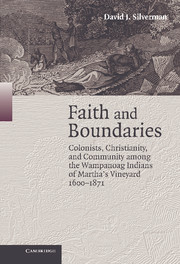 Faith and Boundaries
Faith and Boundaries Book contents
- Frontmatter
- Contents
- Maps, Tables, and Figures
- Abbreviations
- Preface: Do Good Walls Make Good Neighbors?
- Introduction: Epenow's Lessons
- 1 “Here Comes the Englishman”
- 2 To Become All Things to All Men
- 3 The Lord Tests the Righteous
- 4 Deposing the Sachem to Defend the Sachemship
- 5 Leading Values
- 6 The Costs of Debt
- 7 “Newcomers and Strangers”
- Conclusion: Fencing In, Fencing Out
- Appendix A The Population of Martha's Vineyard
- Appendix B A Cross-Comparison of Indian Race Descriptions
- Index
5 - Leading Values
Published online by Cambridge University Press: 17 December 2010
- Frontmatter
- Contents
- Maps, Tables, and Figures
- Abbreviations
- Preface: Do Good Walls Make Good Neighbors?
- Introduction: Epenow's Lessons
- 1 “Here Comes the Englishman”
- 2 To Become All Things to All Men
- 3 The Lord Tests the Righteous
- 4 Deposing the Sachem to Defend the Sachemship
- 5 Leading Values
- 6 The Costs of Debt
- 7 “Newcomers and Strangers”
- Conclusion: Fencing In, Fencing Out
- Appendix A The Population of Martha's Vineyard
- Appendix B A Cross-Comparison of Indian Race Descriptions
- Index
Summary
When minister Zachariah Hossueit Sr. drew his final breath in June of 1772 it was a time for the people of Aquinnah both to mourn and celebrate. For almost half a century Hossueit had been their unrivaled master of the written word, dispensing the gospels to his flock in plain speech and interpreting the Wampanoag language for colonial authorities. He had used every conceivable tool at his disposal to unite his community behind a landed order based on shared resources instead of personal profiteering. More than once he had called Boston's attention to the corruption of the Indians' guardians and won redress. Not the least of all, he was a role model of sober godly living at a time when the Indians needed it most. The people mourned because now this local hero was gone.
Yet there was cause for rejoicing. Hossueit's career spanned an era in which other New England Indians were starved for leaders to defend their homelands. The Narragansett and Mohegan sachems were in league with colonial land sharks, and every campaign to rein them in became bogged down in bitter factionalism and litigation. Prospects were so dismal by the eve of the Revolution that the mainland Indians' brightest stars, Samson Occum and Joseph Johnson, convinced portions of seven tribes to abandon their ancestral territories for a new start among the Oneidas in upper New York.
- Type
- Chapter
- Information
- Faith and BoundariesColonists, Christianity, and Community among the Wampanoag Indians of Martha's Vineyard, 1600–1871, pp. 157 - 184Publisher: Cambridge University PressPrint publication year: 2005
